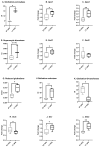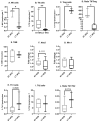Long-Term High-Fat Diet Limits the Protective Effect of Spontaneous Physical Activity on Mammary Carcinogenesis
- PMID: 38892407
- PMCID: PMC11172547
- DOI: 10.3390/ijms25116221
Long-Term High-Fat Diet Limits the Protective Effect of Spontaneous Physical Activity on Mammary Carcinogenesis
Abstract
Breast cancer is influenced by factors such as diet, a sedentary lifestyle, obesity, and postmenopausal status, which are all linked to prolonged hormonal and inflammatory exposure. Physical activity offers protection against breast cancer by modulating hormones, immune responses, and oxidative defenses. This study aimed to assess how a prolonged high-fat diet (HFD) affects the effectiveness of physical activity in preventing and managing mammary tumorigenesis. Ovariectomised C57BL/6 mice were provided with an enriched environment to induce spontaneous physical activity while being fed HFD. After 44 days (short-term, ST HFD) or 88 days (long-term, LT HFD), syngenic EO771 cells were implanted into mammary glands, and tumour growth was monitored until sacrifice. Despite similar physical activity and food intake, the LT HFD group exhibited higher visceral adipose tissue mass and reduced skeletal muscle mass. In the tumour microenvironment, the LT HFD group showed decreased NK cells and TCD8+ cells, with a trend toward increased T regulatory cells, leading to a collapse of the T8/Treg ratio. Additionally, the LT HFD group displayed decreased tumour triglyceride content and altered enzyme activities indicative of oxidative stress. Prolonged exposure to HFD was associated with tumour growth despite elevated physical activity, promoting a tolerogenic tumour microenvironment. Future studies should explore inter-organ exchanges between tumour and tissues.
Keywords: high-fat diet; immunity; mammary carcinogenesis; obesity; oxidative stress; spontaneous physical activity; tumour microenvironment.
Conflict of interest statement
None of the authors have any conflicts of interest to report. The authors are responsible for the content and writing of the paper.
Figures







Similar articles
-
Pubertal high fat diet: effects on mammary cancer development.Breast Cancer Res. 2013;15(5):R100. doi: 10.1186/bcr3561. Breast Cancer Res. 2013. PMID: 24156623 Free PMC article.
-
Modulation of inter-organ signalling in obese mice by spontaneous physical activity during mammary cancer development.Sci Rep. 2020 May 29;10(1):8794. doi: 10.1038/s41598-020-65131-9. Sci Rep. 2020. PMID: 32472095 Free PMC article.
-
Puberty-specific promotion of mammary tumorigenesis by a high animal fat diet.Breast Cancer Res. 2015 Nov 2;17(1):138. doi: 10.1186/s13058-015-0646-4. Breast Cancer Res. 2015. PMID: 26526858 Free PMC article.
-
Voluntary physical activity counteracts the proliferative tumor growth microenvironment created by adipose tissue via high-fat diet feeding in female rats.Physiol Rep. 2017 Jul;5(13):e13325. doi: 10.14814/phy2.13325. Physiol Rep. 2017. PMID: 28676553 Free PMC article.
-
Effects of high fat diet-induced obesity on mammary tumorigenesis in the PyMT/MMTV murine model.Cancer Biol Ther. 2019;20(4):487-496. doi: 10.1080/15384047.2018.1537574. Epub 2018 Nov 2. Cancer Biol Ther. 2019. PMID: 30388923 Free PMC article.
Cited by
-
Causal association of dietary factors with five common cancers: univariate and multivariate Mendelian randomization studies.Front Nutr. 2024 Jul 29;11:1428844. doi: 10.3389/fnut.2024.1428844. eCollection 2024. Front Nutr. 2024. PMID: 39135550 Free PMC article.
-
Comparison of Lean, Obese, and Weight-Loss Models Reveals TREM2 Deficiency Attenuates Breast Cancer Growth Uniquely in Lean Mice and Alters Clonal T-cell Populations.Cancer Res. 2025 Apr 3;85(7):1219-1235. doi: 10.1158/0008-5472.CAN-24-3511. Cancer Res. 2025. PMID: 39841585
References
-
- Ferlay J., Ervik M., Laversanne M., Colombet M., Mery L., Piñeros M., Znaor A., Soerjomataram I., Bray F. Global Cancer Observatory: Cancer Today. Lyon, France: International Agency for Research on Cancer. [(accessed on 21 February 2024)]. Available online: https://gco.iarc.who.int/today.
-
- Tung N., Lin N.U., Kidd J., Allen B.A., Singh N., Wenstrup R.J., Hartman A.-R., Winer E.P., Garber J.E. Frequency of Germline Mutations in 25 Cancer Susceptibility Genes in a Sequential Series of Patients With Breast Cancer. J. Clin. Oncol. 2024;34:1460. doi: 10.1200/JCO.2015.65.0747. - DOI - PMC - PubMed
-
- Möller S., Mucci L.A., Harris J.R., Scheike T., Holst K., Halekoh U., Adami H.-O., Czene K., Christensen K., Holm N.V., et al. The Heritability of Breast Cancer among Women in the Nordic Twin Study of Cancer. Cancer Epidemiol. Biomark. Prev. 2016;25:145–150. doi: 10.1158/1055-9965.EPI-15-0913. - DOI - PubMed
MeSH terms
Grants and funding
LinkOut - more resources
Full Text Sources

